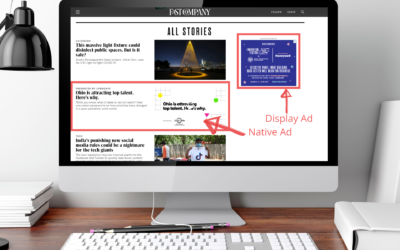The Webinar/Virtual Meeting: How to be the Host with the Most in Your “Office”
(Wherever that may be)
Well, if 2020 is anything more than a wash, it’s also the year that all generations were thrust into working virtually.
I remember going to an employer after setting everyone up to work from home with Google Drive about 10 years ago. When I threw out the idea of working remotely since I wanted to keep my job, but had to move due to my husband’s job, you would’ve thought I’d asked for a $100K raise. The looks? Priceless. “HOW do you think we can do that?!”
Needless to say, I did convince them that the network and processes I implemented were going to help everyone work more efficiently since we weren’t tied to desktops and relying on snail-paced VPNs anymore, and of course, it was a much more affordable option for the employer versus starting over with hiring someone new.
Then again, you still had the holdouts. You know them well – those bosses that don’t know their arm from their leg if you’re not physically IN the office. I mean, how DO they know you’re actually working if they can’t see or hear you typing away?
Where are those bosses now? Two words: at home. Ahhh…to only be a fly on the wall now that we HAVE to work from home.
In any instance, my point is, that all of us, no matter our propensity to flourish virtually or willingness to embark on learning new technologies to get through the day, are working virtually in one way or another.
BUT, that’s not to say there are not challenges. A quick poll on Slack of my client’s workforces all seem to say that the one hurdle most everyone struggles to overcome is, you guessed it, hosting webinars and meetings.
“How do you know if you’re actually on mute?” (PS – be careful if you have an Apple Watch – the WebEx app will allow you to unmute yourself from your watch – whoopsies!) “What are the best practices for the actual video?” Even, “How do I set up the darn meetings?!” These are all questions I get from clients trying their best to adapt.
If this sounds like you, or you just want some tips to hosting your best webinar or meeting ever, then you’re in the right place. We’re going to cover Zoom solely in this article, but most of the information here can also be applied to Google’s Meet, WebEx, or Join.Me.
Video
- Make sure that “Host” and “Participant” video settings are toggled to the off setting.
- Why? This allows participants to enter with their video “off” so that there’s not that awkward futzing with the camera, light, or even the occasional last bite of food. Participants can then turn their video on whenever they are ready.

- TEST. TEST. TEST.
- Why? It’s simple. You’re going to be on video for a reason, so it makes sense for people to be able to see you; lighting is critical. Don’t sit where you are back-lit by a window.
- Take a look around as to what’s behind you. If it’s in the frame during your test, it will be in the frame during the meeting, so be aware of your surroundings.
Audio
- When asked if you want people to join via computer or phone, set the option to “both.”
- Why? Some people have bad microphones, some people have background noise and need to connect with headphones. Plus, it’s just better to have options in case one isn’t working correctly.

- Mute participants upon entry if you’re going to do all the talking. This eliminates the awkwardness of people finding their mute buttons a little too late (like when someone’s 3-year-old decides that the beginning of the webinar is the best time to start crying).
- (This is found under “Advanced options”)

- TEST. TEST. TEST.
- Why? Same as above for video – you’re going to have to be able to be heard easily by the audience. Make sure there aren’t any distracting noises, and at the very least, that your mic is working.
Password
- Zoom now makes this mandatory as of a recent update. Set something hard, but not too complicated. Also, include this in your meeting invites sent outside of the platform to make sure that you aren’t getting texts like, “What’s the password? I can’t get in,” while you’re in the middle of getting the meeting going.
- Use something professional. “FuzzyBear123” is sure to knock your perceived credibility down a few notches – just sayin’.
Waiting Room
- A waiting room is used to control entry to a meeting. Participants can be allowed entry as desired: either one at a time or all at once.
- This is helpful if you want people to know that yes, they are connected, but don’t want to share your video or mic before you’re ready, or if you need to make last-minute adjustments with your co-host.
- Bonus: It’s pretty cool to see the numbers keep going up when you finally start the meeting, too, if attendance is what you’re going for…50…no, 54…wait, 75 attendees, and counting?!
- While in the waiting room, attendees can check their mics, video, etc. without worrying about interrupting the meeting.
- NOTE: Be sure to “disable the waiting room” after the meeting has started. That way, you don’t have to keep letting attendees in if they jump out and need to jump back in.
Sharing Your Screen
- There are lots of options here. Share screen, tab, entire browser window, etc.
- Be sure that you test and re-test this if you plan to share so that you’re not accidentally sharing your email inbox for all to see (and read) while you’re presenting a slide in another window.
Co-Hosts
- Meetings can only have one host, but many co-hosts.
- This is super helpful when you have a large meeting or are allowing questions via the chat window as any co-host can then answer the questions.
- Say someone joins the meeting, and you feel that the information they have should be presented as if they were a host? No problem; just promote them as a co-host by clicking on the drop-down by their name and selecting “promote to co-host.”
General ZOOM Hosting Best Practices:
- Speak clearly and do not rush
- Helps with comprehension
- Not everyone has 100Mbps internet. This gives those with slower connections the chance to catch what you’re saying.
- Animate your delivery
- Use inflection and tone changes
- No one wants to sit through this:

- Treat your attendees as if they are still right in front of you.
- Ask the attendees questions directly.
- Look at the whole screen and not at yourself.
- Use the ‘Manage participants’ control at the bottom of the screen during a meeting to remove someone from the meeting or lock the meeting to prevent others from joining (even if they have a Meeting ID and password).
There are some super cool advanced options available, too, like adding panelists, using cloud recordings, on-demand, etc. But only venture into these once you feel comfortable.
Even justing getting to the point of feeling comfortable will make you look like a pro at hosting!
Now zoom on out of this article and get to hosting like a pro!
Shameless plug: Webinars? Yes, we do that! We can handle everything from marketing your webinar on LinkedIn (for those that need to drum up an audience) to running the technical side of the webinar while you handle the presenting; we can even run the slides for you! Give us a call or shoot us an email to learn more.





0 Comments